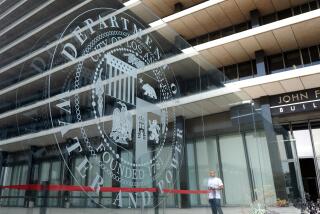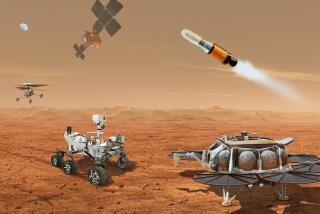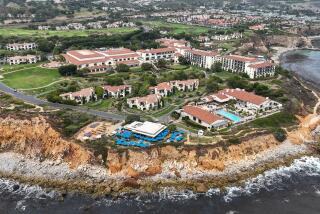Super-Collider Perks Under Investigation : Science: Documents show costly parties and catered lunches. Officials say expenses are legal but some were inappropriate.
WASHINGTON â As the superconducting super collider fights to survive a shrinking federal budget, there are signs that the Texas-based project already has become encrusted with perquisites, featuring lavish Christmas parties, expensive cosmetic frills and the kind of budget abuses that have been associated with big defense contracts.
To critics, the nerdy science project is beginning to look like it got a $200 haircut.
Government documents show that tax money has paid for such items as two $12,000 Christmas parties at Dallas hotels, $25,000 worth of catered lunches and $21,000 to buy and water office plants in 1991.
âSome of the expenditures may have been in poor taste, if nothing else,â said Edward J. Siskin, general manager of the massive project. âIt was not illegal or in violation of regulations. It is a question of perception and we are reacting accordingly.â
About $500,000 in spending over the last three years is under scrutiny by auditors for the Energy Department and congressional investigators, according to Siskin and congressional sources. No decision has been made on whether the government will seek reimbursement for any of the expenses.
The scrutiny comes at a crucial time for the $8-billion atom-smashing project. Opposition appears to be growing in Congress, and White House support may be wavering in the face of pressure for cutbacks in federal spending.
The projectâs political clout suffered a blow last weekend when Republican Kay Bailey Hutchison won a special Senate election in Texas. The super collider is being built in Waxahachie, Tex., about 30 miles from Dallas, and Hutchison is expected to have less influence with the White House than her Democratic predecessor.
âWe have the best chance weâve ever had to kill it,â said Sen. Dale Bumpers (D-Ark.), a persistent opponent of the project.
The super collider is designed to be the worldâs largest scientific instrument. Housed in a 54-mile oval tunnel, it would be a powerful particle accelerator that would allow physicists to examine the properties of matter and energy and possibly unlock clues to the origin of the universe.
Before construction began, there were concerns about costs. The original $4.4-billion price tag has risen to $8.3 billion, according to the Department of Energy, which is overseeing the effort.
However, a report last month by the General Accounting Office, the investigative arm of Congress, warned that the project is over budget and behind schedule and predicted that costs will exceed $11 billion.
Energy Secretary Hazel R. OâLeary and project officials disputed the GAO assessment. With $1.6 billion spent, they said, the project is on schedule and its eventual cost will be in line with the $8.3-billion figure.
âIt would be folly to stop this extremely important project midway,â said John Toll, president of Universities Research Assn., the consortium of 80 universities managing the project. âBut I canât predict what Congress will do.â
Last year, the House voted to kill the project. But it was saved in the Senate largely through the intervention of then-Sen. Lloyd Bentsen (D-Tex.), who was chairman of the Finance Committee.
Bentsen is now treasury secretary. His successor as finance chairman, Sen. Daniel Patrick Moynihan (D-N.Y.), suggested Sunday that the project be canceled.
Asked about President Clintonâs position, White House press secretary Dee Dee Myers said Tuesday that he still supports the super collider. But she seemed to hold out the possibility of negotiating its demise as part of a budget compromise.
The specter of questionable spending in conjunction with a rising price tag is giving the super collider a reputation akin to the B-2 bomber when it comes to waste and cost overruns. The perception could prove crippling in an atmosphere in which congressional budget cutters are considering trimming another $35 billion from Medicare.
The Energy Department is examining super-collider expenses and Rep. John D. Dingell (D-Mich.), chairman of the House Energy and Commerce Committee, plans a hearing on super-collider costs later this month after an investigation by his staff.
âThe super collider is an expensive program that could cost as much as $12 billion,â Dingell said. âIf it is needed for valid scientific reasons, we intend to see that the money goes to appropriate uses and not to line the pockets of its contractors.â
Some of the expenses being questioned by auditors and congressional investigators have the ring of defense contractor shenanigans. Siskin and other project officials defended them and said none has been found to violate regulations.
For Christmas, 1991, one of the chief contractors staged a party for 500 at the Adolphus, a posh Dallas hotel. The $12,064 cost, plus $375 for a disc jockey, was passed on to the federal government as necessary for employee morale, according to vouchers.
The 1992 holiday party was at the Hyatt Regency Hotel in Dallas and cost the government another $12,000, according to project officials.
Project managers defended the parties. They said that the affairs reward workers, many of whom are not paid overtime, and help the project compete with private industry for top professionals.
âI have to offer an employment environment that is suitable to getting and keeping the best people,â said Paul Gilbert, project director for the engineering and architectural contractors. âI lose one senior engineer and recruitment costs for a replacement are $10,000 and relocation can be $25,000.â
As for $25,000 worth of catered lunches, Gilbert said that the practice has been curtailed because of current circumstances. However, he said, the lunches were mostly $6 sandwiches for workers who attended meetings on their lunch hour.
Last month, Dingell described what he called questionable charges to the government by the consortium of universities running the program. Among them were $225,000 in scholarships for the children of employees, $12,000 in parties to lobby Congress and $2,000 to insure art in the lobby of one of the offices.
Toll, the consortium president, said that such items as scholarships are necessary to attract scientists from universities, where they sometimes receive tuition waivers for children. At any rate, he said, the costs are a minor part of the $500-million annual budget for the super collider.
The Colliderâs Cost, Objectives
A brief look at the superconducting super collider:
* Description: Worldâs largest scientific instrument for the study of the fundamentals of matter.
* Site: Waxahachie, Tex.
* Estimated cost: $8.3 billion ($5 billion from U.S., $1 billion from Texas, remainder from other countries and sources).
* Estimated completion: 1999
* How it will work: Beams of protons will be sent around a 52-mile tunnel. Traveling in a vacuum at close to the speed of light, the protons will collide, revealing properties of matter and energy.
More to Read
Sign up for Essential California
The most important California stories and recommendations in your inbox every morning.
You may occasionally receive promotional content from the Los Angeles Times.










